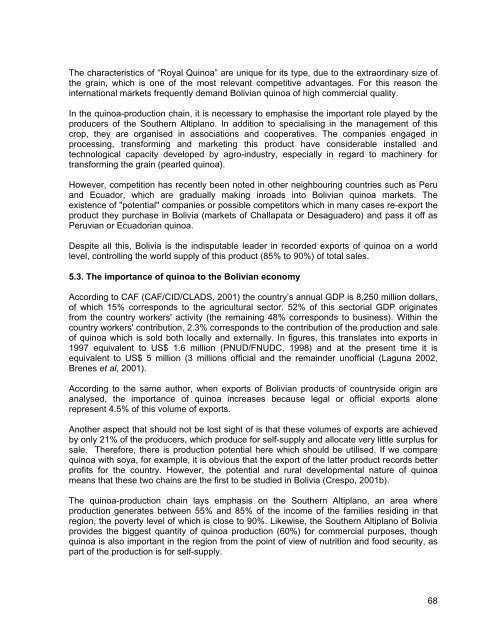Study on the social, environmental and economic impacts of quinoa ...
Study on the social, environmental and economic impacts of quinoa ...
Study on the social, environmental and economic impacts of quinoa ...
You also want an ePaper? Increase the reach of your titles
YUMPU automatically turns print PDFs into web optimized ePapers that Google loves.
The characteristics <strong>of</strong> “Royal Quinoa” are unique for its type, due to <strong>the</strong> extraordinary size <strong>of</strong><br />
<strong>the</strong> grain, which is <strong>on</strong>e <strong>of</strong> <strong>the</strong> most relevant competitive advantages. For this reas<strong>on</strong> <strong>the</strong><br />
internati<strong>on</strong>al markets frequently dem<strong>and</strong> Bolivian <strong>quinoa</strong> <strong>of</strong> high commercial quality.<br />
In <strong>the</strong> <strong>quinoa</strong>-producti<strong>on</strong> chain, it is necessary to emphasise <strong>the</strong> important role played by <strong>the</strong><br />
producers <strong>of</strong> <strong>the</strong> Sou<strong>the</strong>rn Altiplano. In additi<strong>on</strong> to specialising in <strong>the</strong> management <strong>of</strong> this<br />
crop, <strong>the</strong>y are organised in associati<strong>on</strong>s <strong>and</strong> cooperatives. The companies engaged in<br />
processing, transforming <strong>and</strong> marketing this product have c<strong>on</strong>siderable installed <strong>and</strong><br />
technological capacity developed by agro-industry, especially in regard to machinery for<br />
transforming <strong>the</strong> grain (pearled <strong>quinoa</strong>).<br />
However, competiti<strong>on</strong> has recently been noted in o<strong>the</strong>r neighbouring countries such as Peru<br />
<strong>and</strong> Ecuador, which are gradually making inroads into Bolivian <strong>quinoa</strong> markets. The<br />
existence <strong>of</strong> "potential" companies or possible competitors which in many cases re-export <strong>the</strong><br />
product <strong>the</strong>y purchase in Bolivia (markets <strong>of</strong> Challapata or Desaguadero) <strong>and</strong> pass it <strong>of</strong>f as<br />
Peruvian or Ecuadorian <strong>quinoa</strong>.<br />
Despite all this, Bolivia is <strong>the</strong> indisputable leader in recorded exports <strong>of</strong> <strong>quinoa</strong> <strong>on</strong> a world<br />
level, c<strong>on</strong>trolling <strong>the</strong> world supply <strong>of</strong> this product (85% to 90%) <strong>of</strong> total sales.<br />
5.3. The importance <strong>of</strong> <strong>quinoa</strong> to <strong>the</strong> Bolivian ec<strong>on</strong>omy<br />
According to CAF (CAF/CID/CLADS, 2001) <strong>the</strong> country’s annual GDP is 8,250 milli<strong>on</strong> dollars,<br />
<strong>of</strong> which 15% corresp<strong>on</strong>ds to <strong>the</strong> agricultural sector. 52% <strong>of</strong> this sectorial GDP originates<br />
from <strong>the</strong> country workers' activity (<strong>the</strong> remaining 48% corresp<strong>on</strong>ds to business). Within <strong>the</strong><br />
country workers' c<strong>on</strong>tributi<strong>on</strong>, 2.3% corresp<strong>on</strong>ds to <strong>the</strong> c<strong>on</strong>tributi<strong>on</strong> <strong>of</strong> <strong>the</strong> producti<strong>on</strong> <strong>and</strong> sale<br />
<strong>of</strong> <strong>quinoa</strong> which is sold both locally <strong>and</strong> externally. In figures, this translates into exports in<br />
1997 equivalent to US$ 1.6 milli<strong>on</strong> (PNUD/FNUDC, 1998) <strong>and</strong> at <strong>the</strong> present time it is<br />
equivalent to US$ 5 milli<strong>on</strong> (3 milli<strong>on</strong>s <strong>of</strong>ficial <strong>and</strong> <strong>the</strong> remainder un<strong>of</strong>ficial (Laguna 2002,<br />
Brenes et al, 2001).<br />
According to <strong>the</strong> same author, when exports <strong>of</strong> Bolivian products <strong>of</strong> countryside origin are<br />
analysed, <strong>the</strong> importance <strong>of</strong> <strong>quinoa</strong> increases because legal or <strong>of</strong>ficial exports al<strong>on</strong>e<br />
represent 4.5% <strong>of</strong> this volume <strong>of</strong> exports.<br />
Ano<strong>the</strong>r aspect that should not be lost sight <strong>of</strong> is that <strong>the</strong>se volumes <strong>of</strong> exports are achieved<br />
by <strong>on</strong>ly 21% <strong>of</strong> <strong>the</strong> producers, which produce for self-supply <strong>and</strong> allocate very little surplus for<br />
sale. Therefore, <strong>the</strong>re is producti<strong>on</strong> potential here which should be utilised. If we compare<br />
<strong>quinoa</strong> with soya, for example, it is obvious that <strong>the</strong> export <strong>of</strong> <strong>the</strong> latter product records better<br />
pr<strong>of</strong>its for <strong>the</strong> country. However, <strong>the</strong> potential <strong>and</strong> rural developmental nature <strong>of</strong> <strong>quinoa</strong><br />
means that <strong>the</strong>se two chains are <strong>the</strong> first to be studied in Bolivia (Crespo, 2001b).<br />
The <strong>quinoa</strong>-producti<strong>on</strong> chain lays emphasis <strong>on</strong> <strong>the</strong> Sou<strong>the</strong>rn Altiplano, an area where<br />
producti<strong>on</strong> generates between 55% <strong>and</strong> 85% <strong>of</strong> <strong>the</strong> income <strong>of</strong> <strong>the</strong> families residing in that<br />
regi<strong>on</strong>, <strong>the</strong> poverty level <strong>of</strong> which is close to 90%. Likewise, <strong>the</strong> Sou<strong>the</strong>rn Altiplano <strong>of</strong> Bolivia<br />
provides <strong>the</strong> biggest quantity <strong>of</strong> <strong>quinoa</strong> producti<strong>on</strong> (60%) for commercial purposes, though<br />
<strong>quinoa</strong> is also important in <strong>the</strong> regi<strong>on</strong> from <strong>the</strong> point <strong>of</strong> view <strong>of</strong> nutriti<strong>on</strong> <strong>and</strong> food security, as<br />
part <strong>of</strong> <strong>the</strong> producti<strong>on</strong> is for self-supply.<br />
68

















